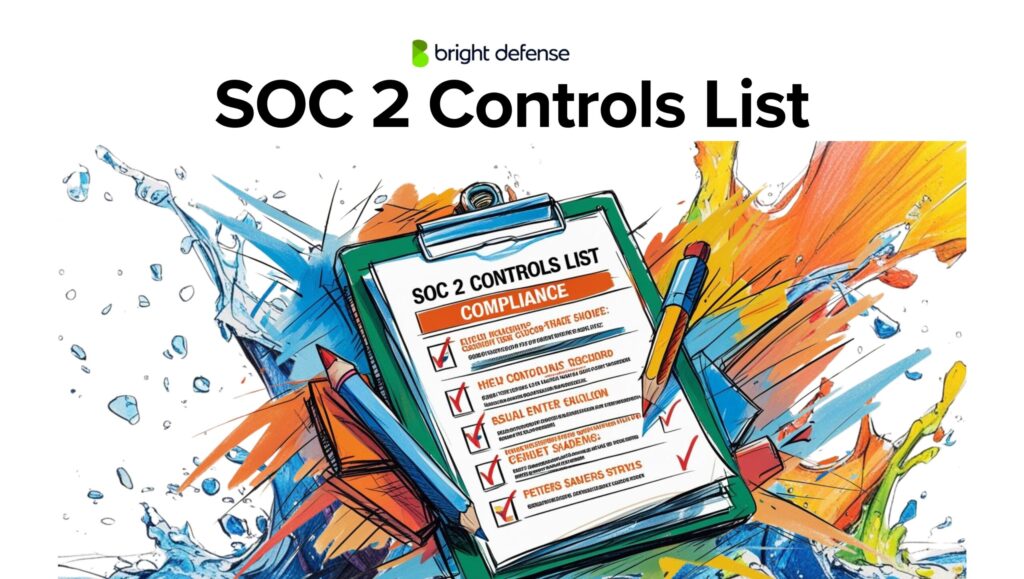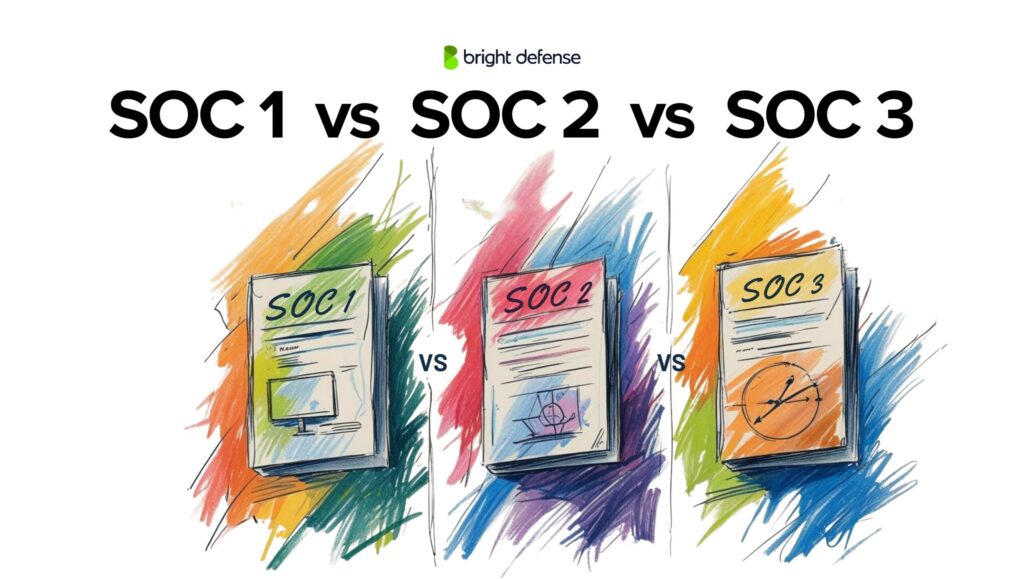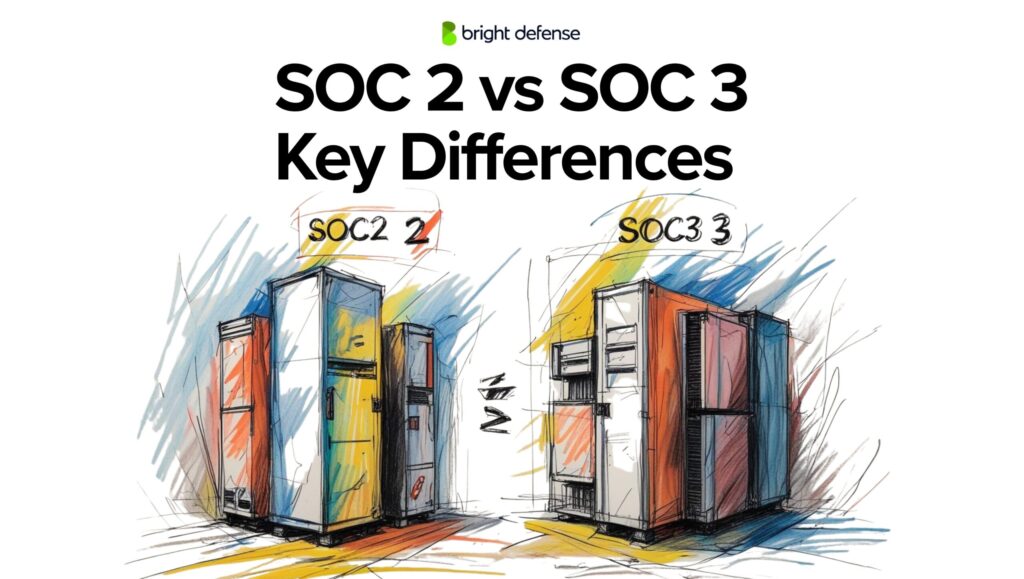
John Minnix - Compliance Strategist
June 30, 2025
The Benefits of SOC 2 for SaaS Providers
In the Software-as-a-Service (SaaS) space, customer data security, availability, and privacy is paramount. SOC 2 compliance for SaaS companies is crucial in building user trust and credibility. Designed specifically for service providers, SOC 2 sets benchmarks for managing data based on five “trust service principles”: Security, Availability, Processing Integrity, Confidentiality, and Privacy.
This blog post will explore the significance of SOC 2 for SaaS providers, discussing its benefits and the challenges SaaS providers encounter during the certification process. Let’s get started!
What is SOC 2 Compliance?
SOC 2 Compliance refers to a rigorous set of criteria that SaaS providers must meet to ensure they handle customer data securely and responsibly. Developed by the American Institute of Certified Public Accountants (AICPA), SOC 2 is specifically designed for service organizations that store, process, or transmit information, ensuring that they safeguard the privacy and confidentiality of their clients’ data.
Definition and Overview of SOC 2
SOC 2 is an auditing procedure that evaluates a company’s information systems through the lens of five trust service principles. These principles are the backbone of SOC 2 and provide a framework for managing data security based on an organization’s operations and industry best practices.
The Five Trust Service Principles
- Security: The system is protected against unauthorized access (both physical and logical).
- Availability: The system is available for operation and use as committed or agreed.
- Processing Integrity: System processing is complete, valid, accurate, timely, and authorized.
- Confidentiality: Information designated as confidential is protected.
- Privacy: Personal information is collected, used, retained, disclosed, and disposed of in conformity with the commitments in the entity’s privacy notice.

Importance of SOC 2 Compliance for SaaS Providers
Unfortunately, 55% of companies have experienced a SaaS security incident. In fact, SaaS applications are the most targeted platform by cybercriminals.
SOC 2 compliance is crucial for SaaS providers not only because it secures customer data. It also builds trust with customers, helps to meet legal and regulatory requirements, and offers a competitive edge in the marketplace.
Building Trust with Customers
Trust is fundamental to the client-provider relationship, especially when providers handle sensitive customer data. In fact, 57% of companies are asked to proved their security measures by prospective clients, according to a survey by Vanta.
SOC 2 compliance assures customers that the provider adheres to high data protection and security practices standards. This assurance is often a deciding factor for businesses when choosing a SaaS provider, as it directly impacts their risk management and compliance strategies.
Aligning with Industry Best Practices
SOC 2 compliance mandates that SaaS providers implement and rigorously adhere to stringent security processes and controls. This commitment to best practices ensures that a provider’s security and operational policies are not only comprehensive but also reflective of the highest standards expected in the industry. By meeting these benchmarks, SaaS companies demonstrate their dedication to security excellence and operational integrity.
Achieving and maintaining SOC 2 compliance involves regular audits and continuous improvements to security protocols. This helps providers keep pace with evolving threats and technological advancements. A proactive approach to security is crucial for maintaining resilience against security breaches and data leaks.
Competitive Advantages in the Market
41% of companies report that a lack of continuous compliance slows down sales cycles. Additonally, 44% of companies include cybersecurity as part of their RFP process.
In a crowded SaaS market, differentiation is critical to attracting and retaining customers and investors. SOC 2 compliance serves as a badge of trust and reliability and demonstrates a commitment to maintaining a secure and robust operational framework. This commitment can significantly differentiate providers, attracting clients who prioritize security in their service selection criteria.
Moreover, investors are increasingly attentive to the security posture of companies they consider funding. 70% of venture capitalists prefer investing in companies with SOC 2. SOC 2 compliance reassures investors of a company’s commitment to high standards of governance and risk management, making it an attractive investment opportunity. This dual benefit enhances customer trust and investment appeal, giving compliant providers a substantial edge in the competitive landscape.
Achieving SOC 2 compliance is not just about meeting standards. It’s about building a reliable, trustworthy service that appeals to conscious consumers and aligns with legal standards. This directly impacts SaaS providers’ ability to secure and expand their customer base in a competitive environment.

Advantages of Achieving SOC 2 Compliance
Achieving SOC 2 compliance offers numerous advantages for SaaS providers, from enhanced security measures to increased transparency and accountability. These benefits improve internal operations and boost the provider’s market position.
Enhanced Security Measures and Risk Management
One of the primary benefits of SOC 2 compliance is the significant enhancement of security measures. The compliance process requires SaaS providers to implement robust security protocols, which protect against unauthorized access and data breaches. This level of security is maintained through continuous monitoring and updating of security practices to address emerging threats and vulnerabilities.
Additionally, SOC 2’s emphasis on risk management compels providers to identify potential risks proactively and establish preventive measures, thereby minimizing the likelihood of security incidents.
Improved Systems Performance and Reliability
SOC 2 compliance also leads to improvements in system performance and reliability. The standards set forth by SOC 2 encourage providers to optimize their infrastructure and operational processes to ensure that services are consistently available and performant according to the agreed-upon standards with clients. This helps maintain service quality and reduces downtime. These directly impact customer satisfaction and retention.
Increased Transparency and Accountability
SOC 2 compliance enhances transparency and accountability in operations. It requires providers to undergo an annual SOC 2 audit to assess compliance with the stringent SOC 2 standards. These audit reports are often shared with stakeholders, including customers, providing a clear, unbiased view of the provider’s compliance and operational status. This transparency helps build trust with customers and stakeholders, demonstrating the provider’s commitment to high data protection and operational integrity standards.
Overall, the advantages of achieving SOC 2 compliance are comprehensive. They impact not only the technical and operational aspects of a SaaS provider but also contribute to its reputation and trustworthiness in the marketplace.

Challenges of Achieving SOC 2 Compliance
Achieving SOC 2 compliance can be a demanding process for SaaS providers. It presents several challenges that require careful consideration, ranging from financial costs to the complexities of maintaining compliance over time.
High Costs and Resource Allocation
One of the most significant challenges in achieving SOC 2 compliance are the costs involved. This includes the expenses for conducting initial and ongoing audits, investing in necessary technology upgrades, and hiring or training staff to manage compliance processes. Smaller SaaS startups, in particular, may find these costs prohibitive. This can delay or complicate their compliance efforts.
Overcoming Financial Hurdles: Partnering with compliance consultants like Bright Defense can provide a cost-effective solution. We offer tailored services that are priced effectively from small and medium businesses. vCISO services deliver the compliance expertise you require, without the cost of a full-time compliance officer.
Additionally, utilizing compliance automation solutions can streamline many of the processes involved, significantly reducing the labor costs and time required for compliance. Bright Defense’s continuous compliance plans include compliance automation software.
Complexity of Continuous Compliance
SOC 2 is not a one-time certification but a continuous process that requires ongoing adherence to its standards. Maintaining compliance involves regular internal reviews, external audits, and updates to security protocols as new threats emerge and technologies evolve. This ongoing requirement can strain resources and require a persistent focus from the management team, potentially diverting attention from other business priorities.
Simplifying Continuous Compliance: Compliance automation solutions play a critical role here, automating routine compliance tasks, monitoring compliance status in real-time, and providing alerts when deviations occur. This technology allows companies to maintain continuous compliance with less manual effort.
Furthermore, Bright Defense can help manage the complexity by providing ongoing support and expertise. This ensures that SaaS providers stay ahead of regulatory changes and industry best practices.
Technical and Operational Hurdles
The technical requirements for SOC 2 compliance can be extensive. They require SaaS providers to implement specific security measures, data management practices, and other control mechanisms.
Adapting existing systems to meet these requirements often involves significant changes to software, hardware, and operational procedures. This can be complex and time-consuming. Additionally, training employees to follow new security protocols and understand the importance of compliance can be challenging but is essential for ensuring everyone adheres to the required standards.
Addressing Technical Challenges: Leveraging compliance automation tools can alleviate many technical burdens associated with SOC 2 compliance. These tools can help implement and manage the required controls efficiently and effectively.
Partnering with a compliance consultant like Bright Defense can also be beneficial. We provide expertise and guidance on best practices and help tailor solutions to the business’s specific needs. This ensures that technical and operational adjustments are both effective and minimally disruptive.
While the benefits of achieving SOC 2 compliance are substantial, the path to getting there is often fraught with challenges. By partnering with expert consultants and leveraging automation technologies, SaaS providers can navigate these challenges more effectively, ensuring they achieve compliance and sustain it efficiently as part of their ongoing operations.

Conclusion
Achieving SOC 2 compliance is a significant undertaking for any SaaS provider, but it is an essential step in ensuring their services’ security, reliability, and integrity. The journey toward SOC 2 compliance involves a deep commitment to maintaining rigorous security standards and operational best practices. While this process presents challenges, the advantages SOC 2 delivers for SaaS providers usually outweighs the costs.
By becoming SOC 2 compliant, SaaS businesses enhance their security and operational efficiency and strengthen their market position by building trust with customers and attracting potential investors. Compliance’s advantages—such as improved risk management, increased transparency, and better performance—contribute directly to a provider’s long-term success and sustainability.
To effectively overcome the hurdles associated with SOC 2 compliance, SaaS providers can benefit significantly from partnering with compliance consultants like Bright Defense and utilizing compliance automation platforms. These resources can provide the necessary expertise, reduce the burden of compliance activities, and ensure that providers sustain the rigorous standards required by SOC 2.
Bright Defense Delivers SOC 2 for SaaS Companies!
If your SaaS business is ready to achieve SOC 2 compliance, Bright Defense is here to help. We protect SaaS providers from cybersecurity threats through continuous compliance. Our monthly engagement model delivers a strong security posture that meet SOC 2 compliance requirements. All of our continuous compliance plans include compliance automation software to increase efficiency and decrease cost.
Does your business need to meet multiple compliance frameworks? Our service frameworks including HIPAA, NIST, PCI, and ISO 27001. Our additional services include vCISO services, gap analysis, business continuity planning, mobile device management multifactor authentication, security awareness training, and more.
Begin your compliance journey today with the help of Bright Defense!
FAQ: SOC 2 Compliance for SaaS Providers
What is SOC 2?
SOC 2 (Service Organization Control 2) is an auditing procedure designed to ensure that service providers manage and protect customer data according to strict criteria. It focuses on non-financial reporting controls related to security, availability, processing integrity, confidentiality, and privacy of a system.
Why is SOC 2 compliance important for SaaS providers?
SOC 2 compliance is crucial for SaaS providers because it demonstrates a commitment to security best practices and data protection. Compliance helps build trust with potential customers, enhances competitive advantage, and addresses security concerns by adhering to recognized standards.
What are the trust service criteria in SOC 2?
The trust service criteria in SOC 2 encompass five areas: security, availability, processing integrity, confidentiality, and privacy. These criteria form the backbone of SOC 2 and guide how organizations should manage the security and privacy of sensitive data.
What are the key security controls required for SOC 2 compliance?
Key security controls for SOC 2 compliance include access control measures to prevent unauthorized access to systems, physical access controls to secure facilities, incident response procedures to address security breaches, and risk assessment practices to identify and mitigate security risks.
How do internal controls affect SOC 2 compliance?
Internal controls are essential for SOC 2 compliance as they ensure that all aspects of an organization’s operations meet the standards for design and operating effectiveness. These controls help manage and mitigate risks related to the security, availability, and integrity of the service provider’s systems and data.
What is the role of a licensed CPA firm in the SOC 2 audit process?
A licensed CPA firm plays a critical role in the SOC 2 audit process by independently assessing the service organization’s compliance with the trust service criteria. The CPA firm evaluates whether the service organization’s controls are appropriately designed and operating effectively to meet the specified criteria.
How does SOC 2 address physical access controls?
SOC 2 requires organizations to implement physical access controls to secure both the facilities and the data they house. This includes measures like security guards, surveillance systems, and controlled access points to prevent unauthorized physical entry.
What should a SaaS provider include in their risk assessment for SOC 2?
For SOC 2 compliance, a SaaS provider’s risk assessment should identify potential security threats and vulnerabilities, evaluate their impact on the organization, and determine the necessary controls to mitigate these risks. This assessment is foundational for designing effective security and privacy controls.
How can SOC 2 compliance give a SaaS provider a competitive advantage?
SOC 2 compliance can give SaaS providers a competitive advantage by demonstrating to potential customers that the provider meets high standards for security and privacy. This reassurance can be a deciding factor for customers when choosing between competing SaaS offerings.
What does a SOC 2 report contain?
A SOC 2 report contains detailed information about the auditing standards met by the SaaS provider, the scope of the audit, the service organization’s system description, and the auditor’s findings regarding the effectiveness of internal controls in place. The report provides assurance about the provider’s compliance with the relevant SOC 2 criteria.
These FAQs cover fundamental aspects of SOC 2 compliance, aiming to educate stakeholders on its importance, requirements, and benefits, thereby enhancing understanding and implementation efforts among SaaS providers.
Get In Touch



